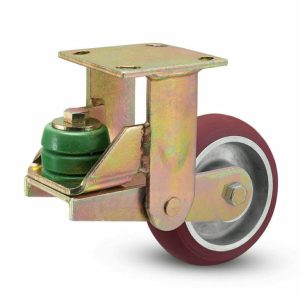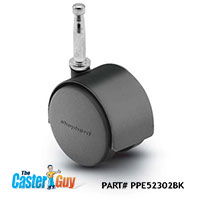Choosing the right casters for your application is crucial to ensure efficient, safe, and smooth operation of your equipment or furniture. Whether you’re outfitting industrial machinery, office chairs, hospital beds, or warehouse carts, the right casters can make a significant difference in performance and longevity. This guide will help you navigate the selection process by considering key factors such as load capacity, wheel material, mounting type, and environmental conditions.
Understanding Load Capacity
One of the most critical factors in selecting casters is load capacity. This is the maximum weight a caster can support without failing. To determine the appropriate load capacity for your application:
- Calculate Total Weight: Determine the total weight of the equipment or furniture, including any maximum potential load it will carry.
- Divide by Number of Casters: Divide the total weight by the number of casters to be used.
- Add a Safety Margin: Incorporate a safety margin to account for uneven weight distribution or dynamic loads. A good rule of thumb is to add 25-30% to the calculated load capacity.
For example, if a cart weighs 400 lbs and carries up to 600 lbs of load, the total weight is 1000 lbs. If the cart uses four casters, each caster should ideally support at least 250 lbs. With a safety margin, a load capacity of 300-325 lbs per caster would be appropriate.
Choosing the Right Wheel Material

Glass Filled Nylon Caster
Wheel material significantly impacts a caster’s performance, durability, and suitability for different surfaces and environments. Here are common wheel materials and their characteristics:
- Rubber: Provides a smooth and quiet ride, ideal for indoor applications on hard floors. It offers good shock absorption but may wear quickly under heavy loads.
- Polyurethane: Durable and versatile, suitable for both indoor and outdoor use. It resists abrasion, chemicals, and provides a cushioned ride.
- Nylon: High load capacity and resistance to wear and tear. Best for hard surfaces but can be noisy and may damage delicate floors.
- Cast Iron/Steel: Extremely durable with high load capacity. Suitable for harsh environments but can damage flooring and be noisy.
- Phenolic: Heat-resistant and non-marking, suitable for high-temperature environments like bakeries or foundries.
Consider the environment where the casters will be used. For example, rubber or polyurethane wheels are better suited for offices or hospitals, while nylon or steel wheels may be more appropriate for warehouses or industrial settings.
Selecting the Mounting Type

Threaded Stem Caster
Casters come with various mounting types, each suitable for different applications:
- Plate Casters: Feature a flat plate with holes for bolts, providing a stable and secure mounting. Ideal for heavy-duty applications.
- Stem Casters: Have a stem (threaded, grip ring, or friction fit) that inserts into a corresponding socket. Suitable for lighter applications like office chairs or light-duty carts.
- Bolt Hole Casters: Similar to stem casters but designed for bolting through a single hole, offering a combination of stability and flexibility.
Choose the mounting type that best matches your equipment’s design and the intended application. For heavy industrial equipment, plate casters are usually preferred due to their robustness.
Considering Environmental Conditions
The operating environment plays a crucial role in caster selection:
- Temperature: High temperatures can degrade rubber and polyurethane wheels, making phenolic or metal wheels more suitable for hot environments.
- Moisture and Chemicals: In wet or corrosive environments, choose casters made of materials resistant to rust and corrosion, such as stainless steel or certain plastics.
- Floor Conditions: Smooth floors are best for hard wheels like nylon or metal, while rough or uneven surfaces benefit from softer wheels like rubber or polyurethane.
Special Features and Functionality

Spring Loaded Caster
Depending on your specific needs, you may require casters with additional features:
- Brakes: Locking mechanisms to prevent movement. Essential for stationary applications or safety requirements.
- Swivel vs. Rigid: Swivel casters offer maneuverability, while rigid casters provide stability. A combination of both can offer a balance of mobility and control.
- Shock Absorption: Casters with built-in shock absorbers are ideal for transporting delicate equipment or in environments with uneven surfaces.
Practical Application Examples
- Office Chairs: Light-duty stem casters with soft rubber wheels to protect flooring and provide smooth, quiet movement.
- Hospital Beds: Heavy-duty plate casters with polyurethane wheels for durability, quiet operation, and ease of movement over various surfaces.
- Warehouse Carts: Rigid and swivel plate casters with nylon or polyurethane wheels for high load capacity and durability on concrete floors.

Furniture Caster
Maintenance and Longevity
Regular maintenance can significantly extend the life of your casters:
- Regular Inspection: Check for signs of wear, damage, or corrosion. Replace worn-out casters promptly.
- Lubrication: Keep swivel and wheel bearings lubricated to ensure smooth operation.
- Cleaning: Remove debris and dirt from wheels and bearings to prevent wear and tear.
Conclusion
Selecting the right casters involves a careful assessment of load capacity, wheel material, mounting type, and environmental conditions. By considering these factors and understanding the specific requirements of your application, you can choose casters that enhance performance, safety, and durability. Whether for industrial machinery, office furniture, or specialized equipment, the right casters can make a significant difference in operational efficiency and longevity.

